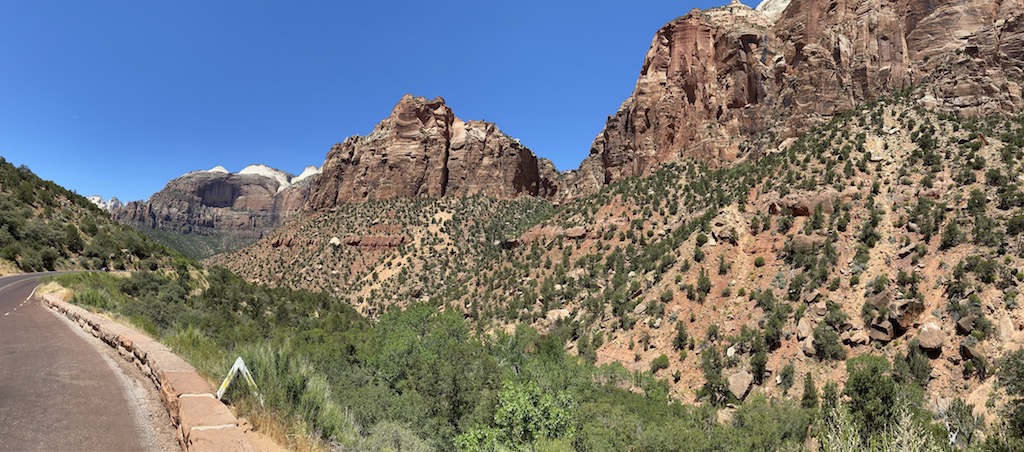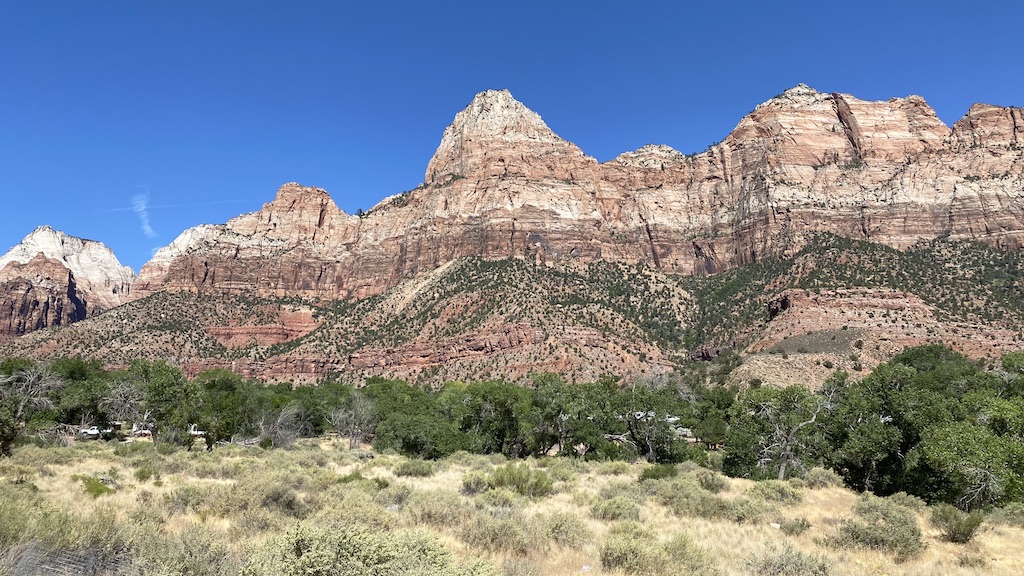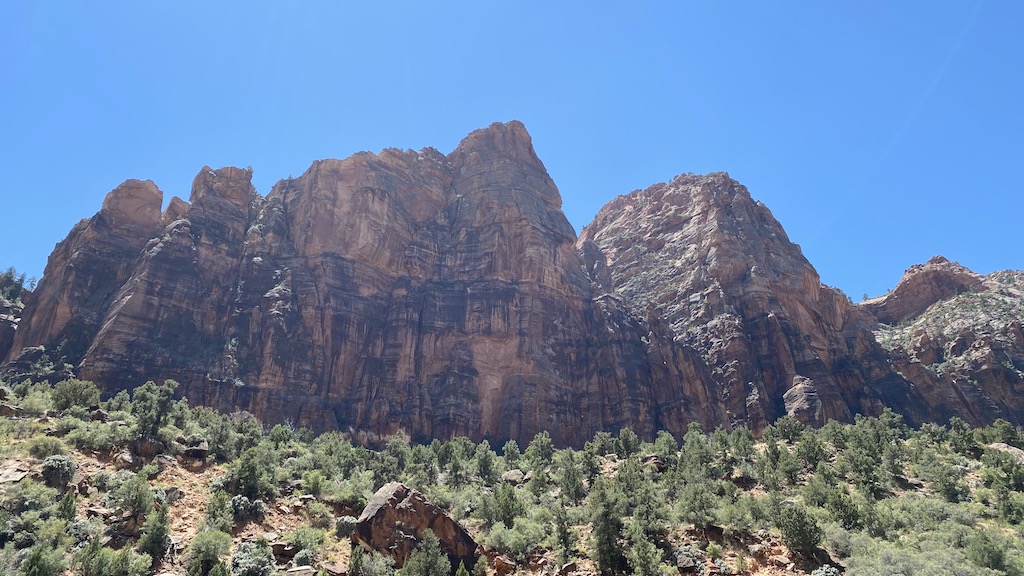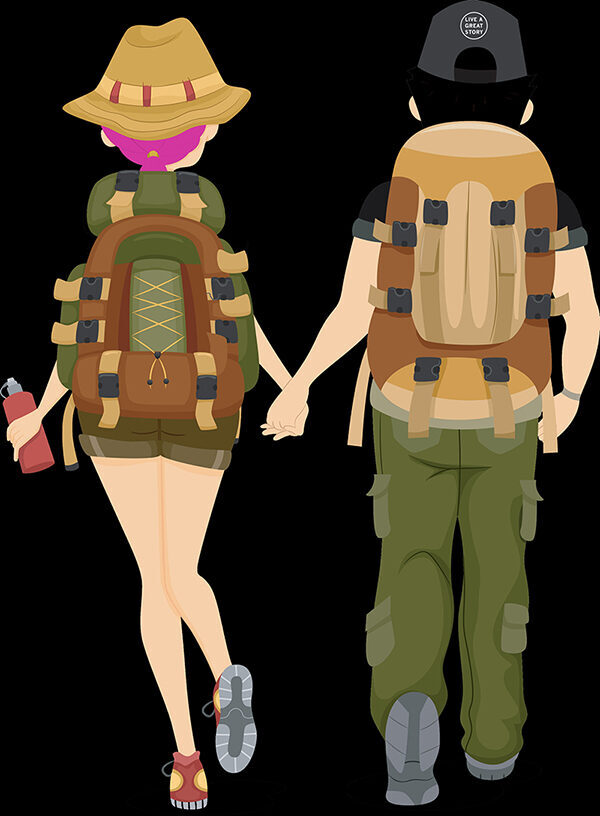Approximately 40 wildland firefighters continue to fight off the 24-acre Kolob Terrace Fire, in Hop Valley, Zion National Park. https://www.nps.gov/zion/learn/news/update-wildland-firefighters-continue-to-address-kolob-terrace-fire.htm

Well we have broken camp in Monument Valley and Saydie and I have headed up to Zion National Park, we booked multiple camp sites at the Watchman Campground in Zion.
For those reading this who have never heard of or been to Zion National Park, hopefully this post will convince you that you need to add it to your bucket list of places to visit.
Zion National Park is an National Park located in southwestern Utah near the town of Springdale. A prominent feature of the 229-square-mile (590 km2) park is Zion Canyon, which is 15 miles (24 km) long and up to 2,640 ft (800 m) deep. The canyon walls are reddish and tan-colored Navajo Sandstone eroded by the North Fork of the Virgin River. Located at the junction of the Colorado Plateau, Great Basin, and Mojave Desert regions, the park has a unique geography and a variety of life zones that allow for unusual plant and animal diversity. Numerous plant species as well as 289 species of birds, 75 mammals (including 19 species of bat), and 32 reptiles inhabit the park’s four life zones: desert, riparian, woodland, and coniferous forest. Zion National Park includes mountains, canyons, buttes, mesas, monoliths, rivers, slot canyons, and natural arches.
History:
Archaeologists have divided the long span of Zion’s human history into three cultural periods: the Archaic, Protohistoric and Historic periods. Each period is characterized by distinctive technological and social adaptations.
Archaic period:
The first human presence in the region dates to 8,000 years ago when family groups camped where they could hunt or collect plants and seeds. About 2,000 years ago, some groups began growing corn and other crops, leading to an increasingly sedentary lifestyle. Later groups in this period built permanent villages called pueblos. Archaeologists call this the Archaic period and it lasted until c. 500. Baskets, cordage nets, and yucca fiber sandals have been found and dated to this period. The Archaic toolkits included flaked stone knives, drills, and stemmed dart points. The dart points were attached to wooden shafts and propelled by throwing devices called atlatls.
By c. 300, some of the archaic groups developed into an early branch of seminomadic Anasazi, the Basketmakers. Basketmaker sites have grass- or stone-lined storage cists and shallow, partially underground dwellings called pithouses. They were hunters and gatherers who supplemented their diet with limited agriculture. Locally collected pine nuts were important for food and trade.
Protohistoric period:
Both the Virgin Anasazi and the Parowan Fremont disappear from the archaeological record of southwestern Utah by c. 1300. Extended droughts in the 11th and 12th centuries, interspersed with catastrophic flooding, may have made horticulture impossible in this arid region.
Tradition and archaeological evidence hold that their replacements were
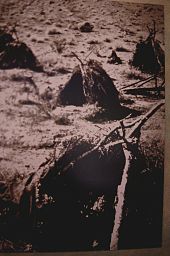
Numic-speaking cousins of the Virgin Anasazi, such as the Southern Paiute and Ute. The newcomers migrated on a seasonal basis up and down valleys in search of wild seeds and game animals. Some, particularly the Southern Paiute, also planted fields of corn, sunflowers, and squash to supplement their diet. These more sedentary groups made brownware vessels that were used for storage and cooking.
Exploration and settlement by Euro-Americans:
The Historic period begins in the late 18th century with the exploration of southern Utah by Padres Silvestre Vélez de Escalante and Francisco Atanasio Domínguez. The padres passed near what is now the Kolob Canyons Visitor Center on October 13, 1776, becoming the first people of European descent known to visit the area. In 1825, trapper and trader Jedediah Smith explored some of the downstream areas while under contract with the American Fur Company.
In 1847, Mormon farmers from the Salt Lake area became the first people of European descent to settle the Virgin River region. In 1851, the Parowan and Cedar City areas were settled by Mormons who used the Kolob Canyons area for timber, and for grazing cattle, sheep, and horses. They prospected for mineral deposits, and diverted Kolob water to irrigate crops in the valley below. Mormon settlers named the area Kolob—in Mormon scripture, the heavenly place nearest the residence of God.
Settlements had expanded 30 miles (48 km) south to the lower Virgin River by 1858. That year, a Southern Paiute guide led young Mormon missionary and interpreter Nephi Johnson into the upper Virgin River area and Zion Canyon. Johnson wrote a favorable report about the agricultural potential of the upper Virgin River basin, and returned later that year to found the town of Virgin. In 1861 or 1862, Joseph Black made the arduous journey to Zion Canyon and was very impressed by its beauty.
The floor of Zion Canyon was settled in 1863 by Isaac Behunin, who farmed corn, tobacco, and fruit trees. The Behunin family lived in Zion Canyon near the site of today’s Zion Lodge during the summer, and wintered in Springdale. Behunin is credited with naming Zion, a reference to the place of peace mentioned in the Bible. Two more families settled Zion Canyon in the next couple of years, bringing with them cattle and other domesticated animals. The canyon floor was farmed until Zion became a Monument in 1909.
The Powell Geographic Expedition of 1869 entered the area after their first trip through the Grand Canyon. John Wesley Powell visited Zion Canyon in 1872 and named it Mukuntuweap, under the impression that that was the Paiute name. Powell Survey photographers John K. Hillers and James Fennemore first visited the Zion Canyon and Kolob Plateau region in the spring of 1872. Hillers returned in April 1873 to add more photographs to the “Virgin River Series” of photographs and stereographs. Hillers described wading the canyon for four days and nearly freezing to death to take his photographs.
It was President William Howard Taft’s proclamation on July 31, 1909 that created Mukuntuweap National Monument. In 1917, the acting director of the newly created National Park Service visited the canyon and proposed changing its name from the locally unpopular Mukuntuweap to Zion, a name used by the local Mormon community. The United States Congress added more land and established Zion National Park on November 19, 1919. A separate Zion National Monument, the Kolob Canyons area, was proclaimed on January 22, 1937, and was incorporated into the park on July 11, 1956.
Travel to the area before it was a national park was rare due to its remote location, lack of accommodations, and the absence of real roads in southern Utah. Old wagon roads were upgraded to the first automobile roads starting about 1910, and the road into Zion Canyon was built in 1917 leading to the Grotto, short of the present road that now ends at the Temple of Sinawava.
Zion National Park has been featured in numerous films, including The Deadwood Coach (1924), Arizona Bound(1927), Nevada (1927), Ramrod (1947) and Butch Cassidy and the Sundance Kid (1969).
On March 25, 2020, the park campgrounds were closed to help prevent the spread of COVID-19.
So we were very fortunate to get to visit the park in July with Covid-19 still spreading in the United States.
Trails:
Seven trails with round-trip times of half an hour (Weeping Rock) to 4 hours (Angels Landing) are found in Zion Canyon. Two popular trails, Taylor Creek (4 hours round trip) and Kolob Arch (8 hours round trip), are in the Kolob Canyons section of the park, near Cedar City. Hiking up into The Narrows from the Temple of Sinawava is popular in summer; however, hiking beyond Big Springs requires a permit. The entire Narrows from Chamberlain’s Ranch is a 16-mile one way trip that typically takes 12 hours of strenuous hiking. A shorter alternative is to enter the Narrows via Orderville Canyon. Both Orderville and the full Narrows require a back country permit. Entrance to the Parunuweap Canyon section of the park downstream of Labyrinth Falls is prohibited. Other often-used backcountry trails include the West Rim and LaVerkin Creek. The more primitive sections of Zion include the Kolob Terrace and the Kolob Canyons. A network of trails totaling 50 miles in distance connect Zion’s northwest corner of the park (Lee Pass Trailhead) to its southeast section (East Rim Trailhead). Popularly known as the Zion Traverse, the route offers backpackers a diverse experience of the park.
Zion is a center for rock climbing, with short walls like Spaceshot, Moonlight Buttress, Prodigal Son, Ashtar Command, and Touchstone being the most popular, highly rated routes.
Now lets get to some of the photos of our trip on day one at Zion National Park.

As you can see our camping pad site was a decent size. We had deer roaming freely through the camp which was cool. The road to the rear of the tent took you to some National Park staff buildings and didn’t disturb us at all.
The pads have fire pits, but there was a burn ban in place so we couldn’t use them. In this photo you can see my camera is out and I am getting it ready to shoot some Milky Way time-lapse shots with a new device I had bought.
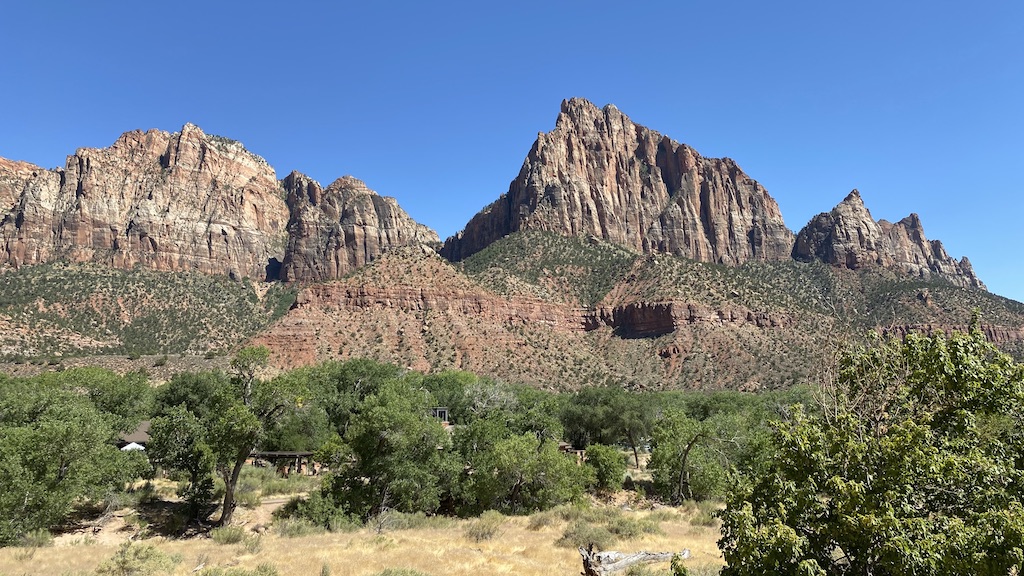
As you can see the views really didn’t disappoint no matter which direction you looked, the views are spectacular.
